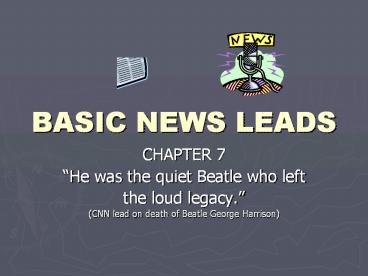BASIC NEWS LEADS - PowerPoint PPT Presentation
Title:
BASIC NEWS LEADS
Description:
Title: Slide 1 Author: harwoodp Last modified by: harwoodp Created Date: 10/4/2006 3:36:33 PM Document presentation format: On-screen Show Company – PowerPoint PPT presentation
Number of Views:84
Avg rating:3.0/5.0
Title: BASIC NEWS LEADS
1
BASIC NEWS LEADS
- CHAPTER 7
- He was the quiet Beatle who left
- the loud legacy.
- (CNN lead on death of Beatle George Harrison)
2
The Leads Needs
- The first sentence or two, or the first
paragraph or two, in a newspaper, magazine, or
online news story is called the lead or lede.
- It is considered the most important part of a
storyand can be the most difficult to write. - The lead should arouse a readers interest.
- Leads often will cover the central point of the
story, not hide it with unnecessary or misleading
words and phrases.
3
Summary or central point leads
- The most common type of lead. It gives the main
or central point of the story. - While every news story should answer six
questions Who? What? Where? When? Why? How?--
the lead is not the place to answer or address
all of them. - The lead should answer only the one or two
questions that are most interesting, newsworthy
and/or unusual.
4
To determine the lead, ask yourself
- What is the most important information? What is
the storys central point? - What was said or done about the topic? What
happened or what action was taken?
- What are the most recent developments? What
happened today or yesterday? - Which facts are most likely to affect or interest
readers? - Which facts are most unusual or out of the
ordinary?
5
Peoples Names dont have to be in leads
- Delayed-Identification Leads In many stories,
the names of the main subjects are not as
important as what those people did or what
happened to them. - For these stories, reporters use leads that
withhold complete identification of the people
involved until the second or third paragraph.
(See examples top of page 150)
6
Leads Avoid headline writing
- Leads must be complete sentences They are not
headlines, so they must include all the necessary
little words, often articles, such as the words
a, an, and the. - Bad lead Six College of Charleston students
arrested last night when police break up downtown
party. (too headlinenot a complete,
grammatically correct sentence) - Better lead Six College of Charleston students
were arrested last night when police broke up a
downtown party.
7
Count your words!
- Lead Length Many readers find a 25-word lead
difficult to read and a 29-word lead very
difficult. A better average would be 18 to 20
words. (see p.152 chart of newspaper lead
lengths) - Reporters should examine their leads critically
to determine whether they are wordy or
repetitious, or contain facts that could be
shifted to later paragraphs. - Broadcast leads are even shorter12 words
8
Elements of Good Leads
- Are specificgood leads contain interesting
details and can help readers or viewers/listeners
visualize the events they describe - Use strong, active verbsa strong word or
descriptive verb can transform a routine lead
into a dramatic one. - Emphasize the magnitude of the storystress the
impact stories have on people
- Stress the unusualby definition, news involves
deviations from the norm - Strive for simplicityevery lead should be clear,
simple and to the point - Localize and updateleads should emphasize your
communities involvement in stories (local angles
and reactions to national, international stories)
9
Good Leads (more)
- Are objective and attribute opinionsreporters
are expected to gather and convey facts to their
readers, not to comment, interpret or advocate. - Reporters may anger or offend readers when they
insert their own opinions. - A lead containing someone elses opinion or
statement must be attributed so readers clearly
understand the opinion is not the reporters.
10
Common Errors with Leads
- Not beginning with the newsyou should stress the
news of the story, not the attribution (example,
p.156) - Dont bury the leadchronological order rarely
works in a news storythe lead should stress the
central point, whats most newsworthy, noteworthy
or unique
- Avoid agenda leadsan opening paragraph that
places too much emphasis on the time and place at
which a story occurred is called an agenda
lead. - Example Yesterday the Cougar baseball team
played a double-header against Clemson at
Patriots Point. - Better At Patriots Point yesterday the Cougar
baseball team swept a double-header from Clemson.
11
More Common Errors with Leads
- Avoid label leads--Label leads mention a
topic but fail to reveal what was said or done
about the topic. Leads must report the substance
of a story, not just its topic. - Example The City Council Tuesday night
discussed ways of regulating underage drinking
downtown. - Better The City Council Tuesday night examined
several fake ID cards and approved new guidelines
to help bar owners crack down on underage
drinking downtown.
12
Also Avoid
- Lists- can be dull
- Platitudes-- avoid stating the obvious or
stressing the routine in leads (p.158) - The negative- report what happened, not what
failed to happen or what does not exist (p.158)
- Exaggerationif a story is weak, exaggeration is
likely to make it weaker, not stronger - Misleading readers/viewersevery lead must be
accurate and truthful
13
Finally
- Critically examine all leads and rewrite them as
often as necessary - First drafts are rarely so well-written that they
cannot be improved - Even experienced professionals often rewrite
their leads three or more times































